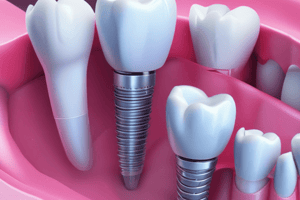Podcast
Questions and Answers
Which type of imaging is particularly useful for cases involving posterior mandible sites and large-span edentulous spaces in the maxillary arch?
Which type of imaging is particularly useful for cases involving posterior mandible sites and large-span edentulous spaces in the maxillary arch?
- Simple radiographic techniques
- X-ray imaging
- Computer-based image software programs
- Computed tomography (CT) scans (correct)
What can render a CT scan unreadable when imaging dental implants?
What can render a CT scan unreadable when imaging dental implants?
- Gum disease
- Bone density
- Metallic restorations (correct)
- Tooth decay
What is the purpose of mucosa-borne drill guides in dental implant surgery?
What is the purpose of mucosa-borne drill guides in dental implant surgery?
- To provide a patient-specific surgical guide
- To produce anatomical stereolithographic models
- To evaluate relationships between proposed implants and ridge morphology
- To transfer planning to a drill guide allowing correct angulation and location of planned implant sites (correct)
Flashcards are hidden until you start studying
Study Notes
Radiographic Examination for Dental Implants
- Simple radiographic techniques may be adequate for some cases, but complex cases require 3D imaging with computed tomography (CT) scans.
- CT scans are particularly useful for cases involving posterior mandible sites and large-span edentulous spaces in the maxillary arch.
- CT scans use X-rays to produce sectional images that can be reconstituted using software programs to create multiplane sections.
- Images can be produced as standard radiographic negative images on large sheets, positive images on photographic paper, or images for viewing on a computer monitor.
- The various scan images can be measured for selection of length and diameter of implant.
- Metallic restorations can produce a scatter-like interference pattern that may render a CT scan unreadable.
- Computer-based image software programs allow clinicians to virtually place implants within the CT scan and evaluate relationships between the proposed implants and ridge morphology, anatomic features, and adjacent teeth.
- Planning data can be used to produce anatomical stereolithographic models useful for the planning, simulation, and optimization of complex surgical cases.
- These models can be used to provide patient-specific surgical guides, which translate planning to a drill guide allowing correct angulation and location of planned implant sites.
- CBCT has led to the development of imaging equipment specifically for dental practice, based on the production of a cone-shaped X-ray beam revolving around the object.
- The development of CBCT has led to the concept of computer-guided flapless surgery.
- Mucosa-borne drill guides can be bone, mucosa, or tooth supported, and allow for the precise intraoperative transfer of preoperative planning facilitating the insertion of a prefabricated provisional prosthesis on the day of implant surgery.
Studying That Suits You
Use AI to generate personalized quizzes and flashcards to suit your learning preferences.




